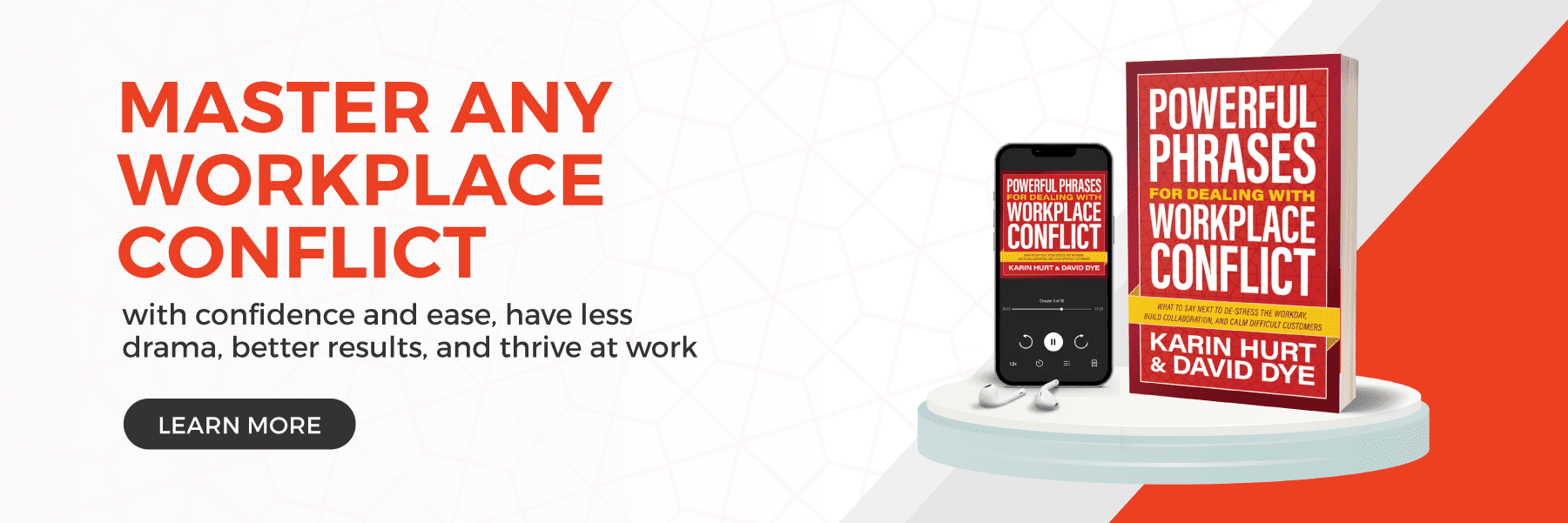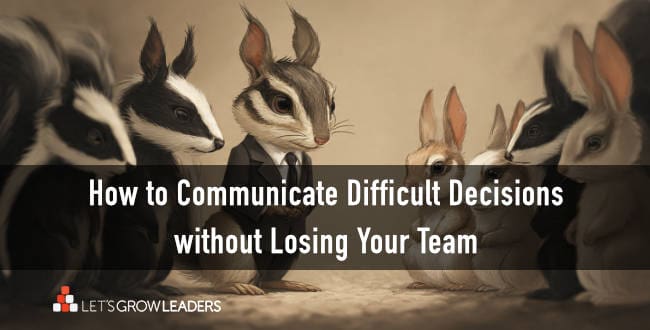When Dealing with Difficult Customers,
Show Up as an Empathetic Expert
Most of the time we write about human-centered leadership, but the challenges of dealing with difficult customers came up so frequently in our World Workplace Conflict and Collaboration Research, we thought we’d take a break from our regular programming to help. Here are some powerful phrases to make communicating with difficult customers easier.
Even Though They Can’t Always Be Right
If you’ve worked with customers for more than a minute, you know that the adage, “the customer is always right” just isn’t true. Which is what makes communicating with them so challenging. Your job is to TRY to make things right for this difficult customer, but you can’t possibly please all the people all the time.
I’ve (Karin) led tens of thousands of customer-facing employees over the years, including managing more contact center and retail customer escalations than I’d care to admit.
And with all that experience, there’s one thing I can say with absolute confidence: it’s statistically unlikely that the difficult customer you’re dealing with, woke up this morning, brushed their teeth, and thought, “You know what might be fun to do today? Let’s make calls or visit stores and be as difficult as possible. I’m gonna stir up some trouble.”
And yet, according to the ACA State of Customer Service and CX, 32% of us admit to having yelled at a customer service agent. In fact, most would rather not even have to call. And, 38% of Americans said they’d rather clean a toilet than call customer service. These scary screamers are likely reasonable human beings most of the time. But the fact that they had to call in the first place, means something’s gone wrong. By the time they got through the self-serve, half-baked AI bots, and a few inane, circular transfers, they unleash their compounded frustration on the first human who will listen.
We get it. Some customers are jerks. (We will not be calling these difficult customers “Karens” for obvious reasons.) The majority are more like you–doing the best they can to get through a tough day. What do they all have in common? A genuine need to be seen and heard.
And so today, as part of our series on Powerful Phrases for Dealing with Workplace Conflict, we bring you a few for dealing with a difficult customer.
Navigating the Blown Fuse, Another Workplace Conflict Cocktail
But first, let’s take a quick look at this complex conflict cocktail (click on the link for a short video).

Powerful Phrases When Dealing with a Difficult Customer
Start with connection and end with a firm commitment. From the very start, your customer needs to feel you understand them and their concern, and that you have the expertise and desire to fix their issue.
“I’m so sorry this happened to you. Let’s fix this right now.”
A good start is always “I’m sorry” and acknowledging their concern and emotion.
“I’m sure that’s incredibly frustrating. That’s certainly not the experience we want you to have working with us.”
Simple statements like these help the customer feel seen, deescalate emotions, and set the tone for a productive dialogue. Even if the customer accidentally drove their car through your storefront plate glass display, you can still express sympathy. (True story. This rates high in the “weirdest calls I’ve ever received” category: “Karin, we’ve got a Honda wrapped around the iPad display. Thankfully, no one is hurt.”) You’re not sorry for their mistake, you’re empathizing with their circumstance.
“I know exactly what we need to do next.” And “I’m on it. I’m not letting you go until we get this resolved.”
Building the customer’s confidence in the first forty seconds of the interaction is another great way to calm a concerned customer. This Powerful Phrase infuses confidence into the conversation and reassures the customer that you care.
“Is that a puppy I hear in the background? Does she chew up the underwear in your laundry basket?”
You want to be curious about their circumstances, experiences, frustrations, and even the cues you’re picking up in the background. Note: This question will either immediately de-escalate the conversation or make it worse as they see it as an attempt to change the subject, so pay attention to the cues.
“Let me be sure I have this right: [Summarize]. What details did I miss that are important for me to understand?”
Especially if your customer has explained their story to someone else, this step is vital. This check for understanding serves two purposes. First, the customer feels heard. And second, it helps ensure you don’t miss vital information.
“What would a successful outcome look like for you?”
This Powerful Phrase clarifies what’s really on their minds. Even if you can’t meet that expectation, it’s better to know what your difficult customer wants.
“Here’s what I’m going to do next. And I’m going to follow up with you tomorrow and ensure we resolve the situation.”
Be sure to use this Powerful Phrase for commitment. After all, the follow-through is what your customer cares about most. What are you going to do next, by when, and how will they know?
When dealing with difficult customers, start with connection, then clarify the situation and your expertise as quickly as possible. Get curious about the circumstances and the best ways to resolve their concern. And close with a confident commitment.
Powerful Phrases for Dealing With Difficult Customers (Summary)
- I’m so sorry this happened to you. Let’s fix this right now.”
- “I’m sure that’s incredibly frustrating. That’s certainly not the experience we want you to have working with us.”
- “I know exactly what we need to do next.” And “I’m on it. I’m not letting you go until we get this resolved.”
- “Is that a puppy I hear in the background? Does she chew up the underwear in your laundry basket?”
- “Let me be sure I have this right: [Summarize]. What details did I miss that are important for me to understand?”
- “What would a successful outcome look like for you?”
- “Here’s what I’m going to do next. And I’m going to follow up with you tomorrow and ensure we resolve the situation.”








0 Comments